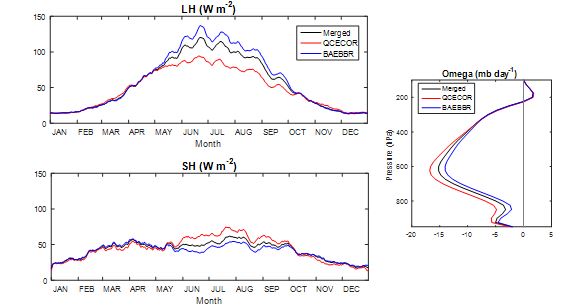Continuous Large-Scale Forcing Data for Cloud Modeling From Southern Great Plains Extended to October 2018
Published: 23 September 2019

Three years of additional data (2016, 2017, and 2018) have been added to version 2 of the continuous large-scale forcing value-added product (VAP), known as VARANAL, from the Atmospheric Radiation Measurement (ARM) user facility’s Southern Great Plains (SGP) atmospheric observatory. This extends the data product to October 2018 and includes both the large-scale forcing terms and the evaluation fields, which can be used for driving single-column models, cloud-resolving models, or large-eddy simulations (LES), including LASSO—the LES ARM Symbiotic Simulation and Observation workflow—and validating model simulations.
The VARANAL VAP version 2 incorporates eddy correlation flux measurement system (ECOR) data into the analysis to better represent various surface types within the analysis domain. Surface latent and sensible fluxes are a merged product from energy balance Bowen ratio (EBBR) and ECOR measurements. Turbulent fluxes are from the Quality-Controlled ECOR (QCECOR) and Bulk Aerodynamic Technique EBBR (BAEBBR) VAPs. The impact of using the merged QCECOR and BAEBBR turbulent fluxes is discussed in Tang et al. (2019).
Background data are also updated from Rapid Update Cycle (RUC) (before May 2012) to the Rapid Refresh (RAP) (after May 2012) analysis. In addition, top-of-atmosphere radiative fluxes were updated to use newly reprocessed satellite data, which include an improved algorithm and several bug fixes.
Analyzed forcing data follow the resolution of the previous version, with 1-hour time resolution and 25-hPa vertical resolution. The data sets are in netCDF format. To see data plots, go to https://portal.nersc.gov/project/capt/ARMVAP/SGP_plot.html.
Scientists can begin using the new version 2 forcing data from VARANAL for model simulation and evaluation. An earlier release of version 2 data, which included data from 2004 to 2015, can be found in this announcement. Note that the continuous forcing data before 2004 were not updated due to the lack of high-quality ECOR data before 2004. Users should use pre-2004 VARANAL data with caution.
For questions or to report data problems, please contact Shuaiqi Tang, Cheng Tao, or Shaocheng Xie. More details about the ARM continuous forcing data set are in Xie et al. (2004) and Tang et al. (2019).
Data can be referenced as doi:10.5439/1273323. To access the data set, please browse the ARM Data Center. (Go here to create an account to download the data.)
References: Tang S, S Xie, M Zhang, Q Tang, Y Zhang, S Klein, D Cook, and R Sullivan. 2019. “Differences in Eddy‐Correlation and Energy‐Balance Surface Turbulent Heat Flux Measurements and Their Impacts on the Large‐Scale Forcing Fields at the ARM SGP Site.” Journal of Geophysical Research: Atmospheres, 124(6), 10.1029/2018JD029689.
Xie S, RT Cederwall, and MH Zhang. 2004. “Developing long-term single-column model/cloud system–resolving model forcing data using numerical weather prediction products constrained by surface and top of the atmosphere observations.” Journal of Geophysical Research: Atmospheres, 109(D1), D01104, 10.1029/2003jd004045.
Keep up with the Atmospheric Observer
Updates on ARM news, events, and opportunities delivered to your inbox
ARM User Profile
ARM welcomes users from all institutions and nations. A free ARM user account is needed to access ARM data.


















